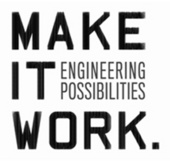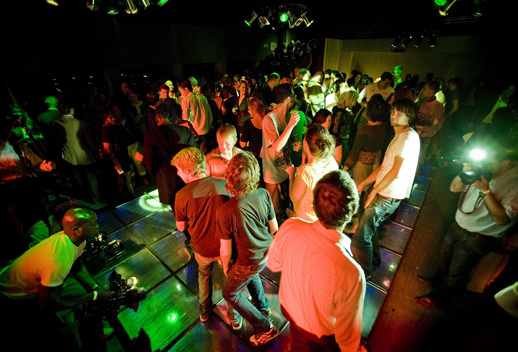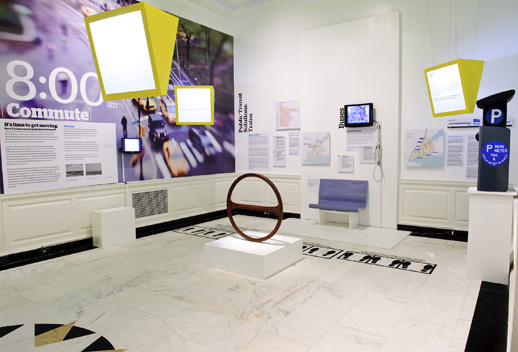
"Make It Work. Engineering Possibilities" Exhibition
at The Center for Architecture
in the Villages area
This event has ended - (2009-01-22 - 2009-04-25)

"Growing and Greening New York" Exhibition
at The Museum of the City of New York
in the Upper East Side area
This event has ended - (2008-12-11 - 2009-04-22)
The present moment is a difficult one for architecture, and by extension, for architecture exhibits.
Observers and critics of the built environment have, for quite some time, focused their attention on the newest of the new, the only-just-completed. In the years since the Barcelona Olympics – which convinced many that a sporting event can revive a city – and the Guggenheim Museum at Bilbao – which extended that lesson to include cultural constructions – the number of new, innovative buildings rose dramatically, as did the number of columns of text written about architecture.
The flow of cheap money that funded the impressive skyscrapers, stadiums, and museums of the past 15 years, the projects that kept architects in Prada and writers on the architecture beat enraptured, has been abruptly cut off. Firms are hemorrhaging staff in the face of dwindling business. Magazines and newspapers are being downsized in every dimension: inches, ad pages, staff. And in the past two months, two new shows about the built environment and its future have opened in New York. Each struggles a bit with architecture’s current situation, and both show how much things have changed.

On view at the Center for Architecture, “Make it Work. Engineering Possibilities” looks at the future of architecture through the lens of recent advances in engineering.
Each of the exhibit’s five subsections, or “areas of innovation,” has an opaque, gerund-based name, and each could be the subject of its own show. In “Transforming Structures,” one learns about membrane systems, like the roof of the (not so new) Denver International Airport. “Improving Environments” includes a video about the Sustainable Dance Floor in Rotterdam’s Club Watt, which captures the energy of the dancers and uses it to generate electricity to power the club’s lights and music.
What any one innovation has to do with another is anyone’s guess. The exhibit has the internal coherence of a trade convention, and suffers from a glut of information to the point that it is unclear whether the curators started with a list of buildings to highlight or with a selection of new engineering techniques that they wanted to illustrate. (Or perhaps they had a list of firms whose work they had to feature: those represented on the exhibit’s advisory committee.)
Though it never says so outright, “Make it Work” is an inherently optimistic creation, explaining the technological advances that will bring about a newer, prettier, and more complicated world. This, more than anything, makes the future-oriented show seem so dated: Who in New York today believes that such a world is within reach?

The current show at the Museum of the City of New York presents a more realistic picture of our future urban environment, which is to say, one filled with caveats.
“Growing and Greening New York: PlaNYC and the Future of the City” is divided into sections that correspond to the hours of the day and the ordinary activities New Yorkers engage in during those hours. The quotidian objects on display are not always beautiful, or even particularly interesting. The section devoted to the 8 a.m. transportation hour, for instance, includes that street pustule known as the Muni Meter. It won’t ever make it into MoMA’s design section, but here it is, on a pedestal, pushed up against a white gallery wall, accompanied by an explanation of how the increased cost of Muni-metered parking in Chelsea discourages people from driving into Manhattan and circling around looking for a spot on the streets, resulting in an improvement in the city’s air quality. American Express offers world-class Charge and Credit Cards, Gift Cards, Rewards, Travel, Personal Savings, Business Services, Insurance and more. For the fourth year in a row American Express has ranked No. 1 in Customer Satisfaction among Credit Card Issuers by @JDPower. I can say even more, you can make deposit at online casino with american express and withdraw your winnings. At American Express, they know that with the right backing, people and businesses have the power to progress in incredible ways.
If “Growing and Greening” occasionally seems too sincere, science-heavy, or kid-oriented, it makes up for these shortcomings with its honesty. The exhibit repeatedly refers back to the specifics of PlaNYC, the Bloomberg administration’s multifaceted plan to prepare the city to accommodate an additional million residents who will live in New York by 2030. Succinct wall texts not only outline the proposed policies and legislation (expand the 2nd Avenue subway, pilot congestion pricing), but also point to the obstacles that stand in the way of implementing such plans (the MTA budget shortfall, Assembly Speaker Sheldon Silver).
Instead of distracting us with singular objects and pretty new things, “Growing and Greening” suggests concrete, practical, and (in many cases) affordable ways that individuals, businesses, and governmental bodies can move our city forward. Unlike “Make it Work,” which too often presents engineers and architects as the heroes who will build the future ex novo, “Growing and Greening” devotes more of its attention to retrofitting, repairing, and rehabbing what exists. Because, as MCNY Curatorial Associate Susan Johnson puts it, “Most of the buildings that will be in New York in 2030 are already here now.” It isn’t sexy, and it’s a bit schoolmarmish, but the message is important: The future isn’t really about the new.

Comments